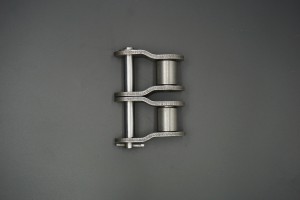Roller chains are an essential component in a variety of industrial applications as a connecting mechanism providing seamless power transmission. Knowing the number of links per foot of a roller chain is critical to determining the chain’s size, function and suitability for a particular task. In this blog, we will delve into the details of roller chain, explore its number of links per foot and clarify its importance.
Define the number of links per foot of roller chain:
Before we get into the details, let’s define what we mean by “links per foot” for roller chains. Essentially, it refers to the number of individual links present in one linear foot of chain. Each link consists of two plates, called the inner and outer plates, which are connected together by pins and bushings to form a continuous ring.
Determine link count:
The number of links per foot of roller chain varies depending on the size and pitch of the chain. Pitch is the distance between the centers of two consecutive pins. Common roller chain sizes include ANSI (American National Standards Institute) standards such as #25, #35, #40, and #50. Each size has a unique pitch, which affects the number of links per foot.
For example, let’s consider a #40 roller chain with a pitch of 0.5 inches. Generally, #40 roller chain contains approximately 40 links per foot. Likewise, a #50 roller chain with a pitch of 0.625 inches has approximately 32 links per foot. It must be noted that these counts are approximate and may vary slightly depending on the manufacturer.
Significance of link count:
Knowing the number of links per foot of roller chain is critical for a number of reasons. First, it helps to determine exactly the length of chain required for a particular application. In situations where the chain needs to be shortened or lengthened, knowing the number of links can help achieve the desired length without compromising functionality.
Second, link counting helps to calculate the weight of the chain, making it easier to estimate the carrying capacity. In heavy-duty applications, where chains are subjected to significant forces, knowing the number of links per foot is critical to maintaining safety and preventing premature wear or failure.
Finally, understanding link counts is crucial for replacement purposes. When roller chain wear occurs, replacing it with the correct number of links ensures seamless compatibility with existing systems. Mismatched link counts can result in improper splicing, reduced efficiency, and even system corruption.
The number of links per foot of a roller chain plays an important role in determining its size, function and suitability for various applications. Knowing the number of links helps to accurately calculate chain length, estimate load capacity and ensure proper replacement. As industries continue to rely on roller chains for their power transmission needs, understanding link count becomes an important aspect of their efficient operation.
The next time you come across a roller chain, notice its number of links per foot and appreciate the intricate details that make this critical mechanical component work seamlessly in a variety of industrial environments.
Post time: Jul-14-2023

